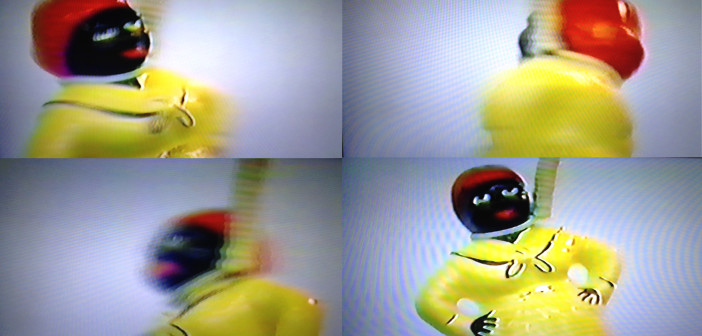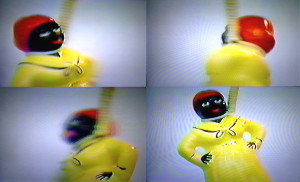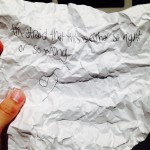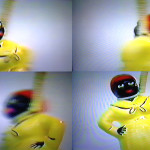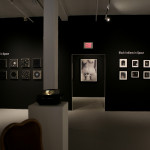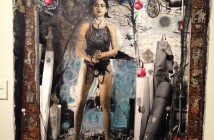“[Women] are sex objects, spoils in the war between white males and black males over which group will dominate the planet.”[1]
Much of Persuasions 1990—2015, the mid-career survey of Rhode Island-based visual and performance artist James Montford (recently on view at the Mills Gallery at the Boston Center for the Arts), is constituted by investigations of blackness and shortsightedness. Montford’s prolific use of afronauts, black holes, and cosmic dark matter (outer space populated with the artist’s signature pantheon of racialized celestial bodies), floating in mathematical freedom amidst the colorful and seemingly endless night of the expansive universe, suggests an awareness, or at the very least, a subconscious channeling of the limited human perceptual systems that tie both of these conceptions of blackness together. The universe, locked into permanent darkness through our inability to perceive the full spectrum of its receding wavelengths, is thus linked to humanity’s dogmatic identification with biological determinism and the violent consequences that result from our ever-waning willingness to recognize and truly see with the so-called other.
Like Aimé Césaire’s lyrical and introspective deployment of the pitch-black veneer of the Caribbean mangrove swamp, Montford’s recurrent collages on canvas conjure visions of deep, blackened space while confronting viewers: “a surface without any real depth that permits one to observe the structures of one’s condition”[2] is held up to the viewer like a mirror, brandishing largely familiar constellations of cut-paper stereotypes, while one awaits in the mimetic mire of that culturally-reflective finish, hoping to discover a new, hidden truth beneath the inappropriate cartoon shallows.
“The look is that of forests. / The lulling / that of the swaying of tides.”[3]
Montford’s frequent and committed engagement with notions of colonized psychology and subjectivity, or lack thereof, repeats subtly, if a bit laboriously, through the show’s presentation of the artist’s work in other media, including: documentation of past performances, studio texts, maps, videos, installations and an archive. Throughout the show, parallels with the writings of postcolonial giant Frantz Fanon are apparent in terms of the influence of the latter on the content of the artist’s work. Fanon’s shortcomings, however, also became increasingly more distinct through a closer examination of Montford’s complicating racial looking glass.
“[one] may ask what we have to say about the woman of color–
I know nothing about her."[4]
The thematic section at the rear of the gallery, Mammy Trajectories, houses Montford’s out-sourced photographic series, Guardian Figures, consisting of three large black and white photographs—intimate compositional relationships between faceless sexualized nude white female bodies and a small black mammy pepper shaker, Peppy.
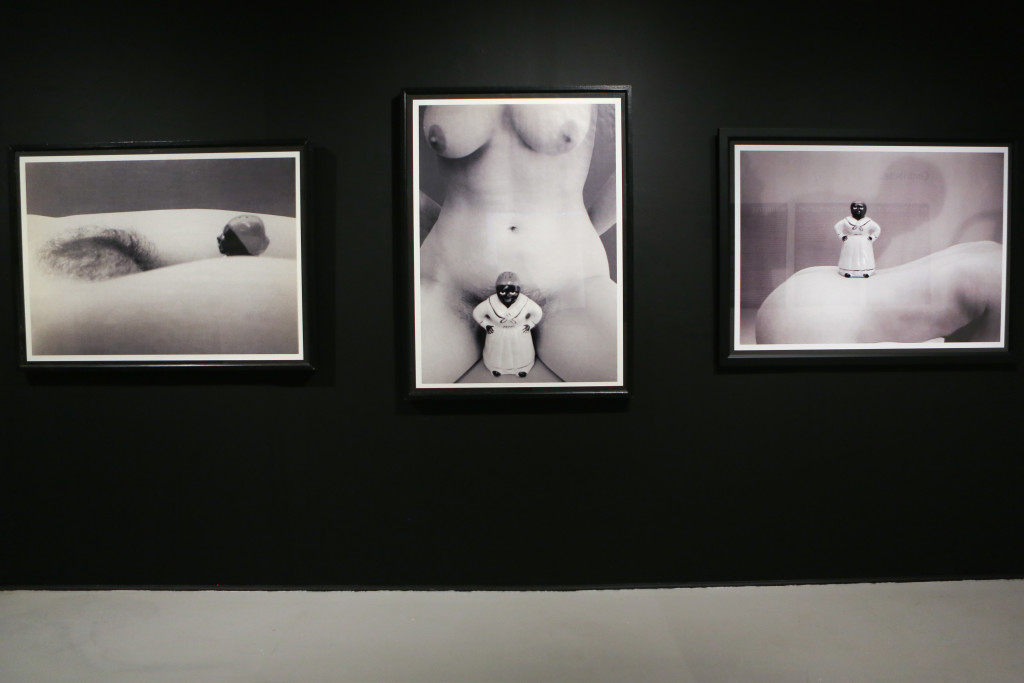
James Montford, Guardian Figures #2, #1, and #3,
2000.
Photo: Melissa Blackall Photography 2015, installation view Boston Center for the Arts
The Guardian Figure series is hung in non-sequential order (Guardian Figures #2, #1 and #3), evoking an Olympic medal awarding ceremony orientation that favors the verticality of the champion athlete in the middle, with the runner-ups standing lower and at either side. The center photograph, Guardian Figure #1, is doubly flanked by the gallery walls, ushering viewers into the physical and psychological space of this body of work.
Similarly, the piece, when viewed from the main gallery space, appears crowned underneath the bright red sign demarcating the emergency exit. A necessary design feature that nonetheless provides a fitting cranial substitution for this compositionally beheaded torso of the taboo. The Guardian Figures are likewise situated between two doors at this extreme end of the gallery—one of which leads, awkwardly, to a storage room, the other to a water closet followed by a hallway and set of stairs that spits you out into a back alley. The photographs are effectively book-ended by spaces that denote accumulation and evacuation, respectively— orifical signifiers pantomiming the bodily dance of ingress and egress that these silent bodies present to viewers.
Montford's series gives us not portraits of white women, but rather, de-natured portrayals of white bodies—landscapes primed for male projection, the imprinting gaze of the viewer/creator. They represent not people, but ideals—anonymous pillars of desire and constructed psycho-geographies, which come adorned with a keeper. But the tension between what or whom Peppy the mammy is protecting, along with the question of the need for such protection, remains one of the most frustrating aspects of this unquestionably alluring series of photographs.
Guardian Figures #1 and #3 feature Peppy in a firm stance, with outwardly pointing elbows denoting power and aggression. She guards the entrance to the white body’s vagina in one photo and stands near the body’s anus in another. Guardian Figure #1 features a white torso with arms pulled behind the abdomen, while in Guardian Figure #3, the arms are pressed down into the floor to support its weight—both are an interesting contrast of submission in relation to Peppy’s domineering posture. But while #1 appears to underscore a demeanor of protection (though the recipient of this benevolence is unclear), #3 connotes an air of conquest: both photos indicate Peppy’s surprising domination of this larger, subdued and feminized white body. It is as if Peppy is protecting the white woman’s purity (almost like a chastity belt) in one, and warning the black male against interracial sex in the other; a visual history lesson for the way white males’ construction of the mammy archetype has functioned on multiple levels to safeguard the master’s property.
Guardian Figure #2, on the viewer's left, is doing something completely different. Peppy’s body, in this case, is obscured below the neck by the right upper thigh of the human body, which now appears almost in a comfortable state of repose. Peppy, once rigid and resolute in her guardianship—defiantly returning the viewer’s gaze—now appears to us in profile. We assume that the pepper shaker figurine is still the same one (as we might assume the model has been the same), but Peppy’s expression seems to have changed along with her positioning. The photographic image is more tightly cropped than the other two, narrowing the scope of our attention to a particular part of the large white female body: the reproductive region. Peppy stares directly ahead—facing just a few centimeters away from what Joel Chandler Harris may have intended to signify with his immensely popular 19th century creature fables concerning a certain Briar Patch and several anthropomorphized animals that were described in their relations with Miss Meadows as being just “dat flirtashus”.[5]
At this scale, the modest patch, seen through Peppy’s ceramic eyes, must appear tall and imposing, perhaps even swaying in the gentle breeze produced by a climate-controlled photography studio. I imagine Peppy looking directly into this Medusa of pubic hair the way slaves on a cane field in the Caribbean might have looked up at a dancing wall of that interminable sweet grass—machete in hand, whip at the back, sun and sweat in their eyes—looking, perhaps, not unlike Sisyphus as he glanced from his boulder to the mountain and back again. We can read this moment as a resignation, or we can read it as Albert Camus would have us understand the Sisyphean dramatic myth—a tale of imposed repetition, of a tedious physicality, which will one day bear the fruit of its own destruction—a revolutionary gaze into the fields. But it might also underscore the essential difference between these two female entities. The differences aren’t inherent, but imposed by the lingering plantation psychology of our society. The white woman’s body, her sex, ever the more desirable, literally engulfs Peppy in the picture frame. A slap in the face that reinforces the state of black femininity/sexuality as valueless when compared to the pink-fleshed pedestal.
“white and black women never meet, they exist in a world apart.”[6]
bell hooks, cultural theorist known, appreciated, and reviled for her sharp, feminist critique of the prevailing liberatory sexism found throughout much of the male-authored postcolonial work being done in the visual arts and academia, acutely identifies the problem with popular representations of interactions between white/black men and white/black women. In discussing Spike Lee’s Jungle Fever, hooks notes that: “Within the cultural marketplace, Jungle Fever courted viewers by claiming to address the taboo subject of interracial sex and desire, highlighting black male interactions with white females. Overall, however, the film had nothing new or revelatory to share about race, gender, or desire.” [7]
Montford is giving us the status-quo: showing us what has and continues to be at play regarding the intersections of race, gender, and desire in North America. With the repeated uses of the emblematic and predictable character of the black mammy––ever in the service of since her inception at the hands of white men––Montford’s work runs the risk of perpetuating a romanticized objectification of this intrinsically captive and subservient personage that ensures her enduring lack of freedom, and thus inability to ever adequately protect and guard herself.
Reading the work contextually, one might identify an unconscious solution to her endless patriarchal servitude––a swan song proposed by the artist himself. Directly across from the Guardian Figures, a small monitor plays a looping video of a twirling, rapturous mammy in a yellow dress. She looks content, perhaps even unimpressed, as she spins vigorously from the rope around her neck, lulled by the soft sounds of singing.[8]
As debate rages on about whether certain words or symbols can be wrested from their devastating histories and rehabilitated or rebranded (like Kanye West’s reappropriation of Klan hoods and Confederate flags), I recall a handwritten note contributed by a visitor to the exhibition––left in the gallery, adjacent to these charged images of Montford’s design, in a room christened Mammy Trajectories by the curatorial team: “I’m afraid that this is either so right or so wrong.”[9]
This piece was written with editorial consultation from Chanel Thervil, Tif Robinette, and Céline Browning
--------------------------------------------------
[1] bell hooks, Male heroes and female sex objects
[2] Anette Smith and Clayton Eshelman, introduction to Aimé Césaire: Lyric and Dramatic Poetry 1946-82
[3] Ibid
[4] Frantz Fanon, Black Skin White Masks
[5] Joel Chandler Harris, Uncle Remus: His Songs and His Sayings
[6] bell hooks, Male heroes and female sex objects
[7] Ibid
[8] James Montford, The Exeter Songbook
[9] James Montford, Throwaway Words
- James Montford, ReCreation: “Throw Away Words,” Audience Participation Performance/Paper 1995/2015. Photo: Ian Deleón.
- James Montford, Exeter Song Book, VHS tape, 1989. Photo-composite: Ian Deleón.
- James Montford, Guardian Figure #1, 2002. Photo: Melissa Blackall Photography 2015, installation view Boston Center for the Arts.
- James Montford, Guardian Figures #2, #1 and #3, 2000. Photo: Melissa Blackall Photography 2015, installation view Boston Center for the Arts.

